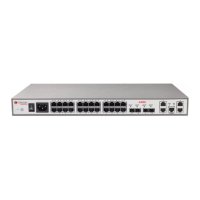A10E/A28E/A28F Configuration Guide
Enter global configuration mode.
Alpha-A28E(config)#interface
ip
if-number
Enter Layer 3 interface configuration
mode.
Alpha-A28E(config-ip)#ip
address
ip-address
[
ip-
mask
] [
vlan-id
]
Alpha-A28E(config-ip)#quit
Configure the IP address for the
A10E/A28E and bind the VLAN of
specified ID. This VLAN is used to open
the Telnet service interface.
Alpha-A28E(config)#telnet-
server accept port-list
{ all |
port-list
}
(Optional) configure the interface in
support of Telnet function.
Alpha-A28E(config)#telnet-
server close terminal-telnet
session-number
(Optional) release the specified Telnet
connection.
Alpha-A28E(config)#telnet-
server max-session
session-
number
(Optional) configure device supports
maximal Telnet sessions.
Telnet Client: when you connect the A10E/A28E through the PC terminal emulation
program or Telnet client program on a PC, then telnet other A10E/A28E and
configure/manage them. As shown in Figure 1-4, Switch A not only acts as Telnet server
but also provides Telnet client service.
Figure 1-4 A10E/A28E as Telnet client networking
Configure Telnet Client device as below.
Alpha-A28E#telnet
ip-address
[ port
port-id
]
Log in to a device from Telnet.
1.1.4 Accessing from SSHv2
Telnet is lack of security authentication and it transports packet by Transmission Control
Protocol (TCP) which exists with big potential security hazard. Telnet service may cause
hostile attacks, such as Deny of Service (DoS), host IP deceive, and routing deceiving.
The traditional Telnet and File Transfer Protocol (FTP) transmits password and data in
plaintext cannot satisfy users' security demands. SSHv2 is a network security protocol, which
can effectively prevent the disclosure of information in remote management through data

